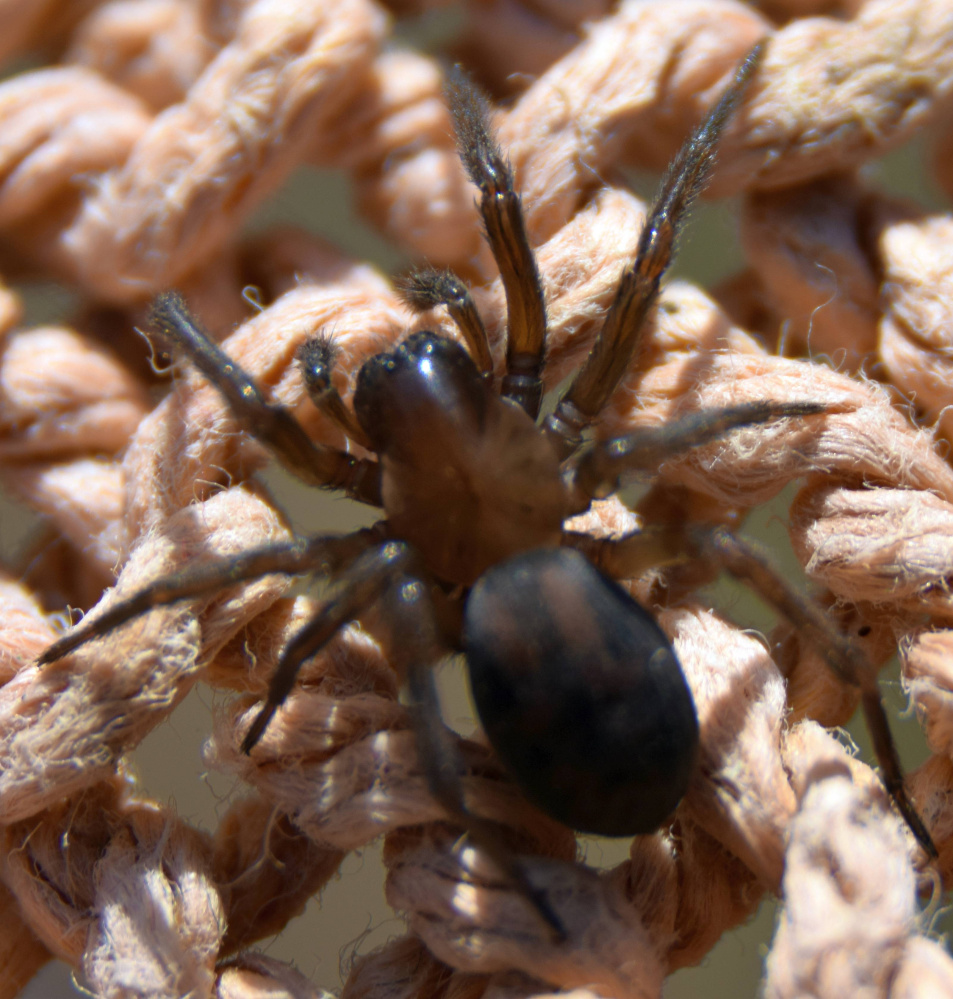The spider population around our house, like pretty much everywhere in these parts, lays pretty low in winter. Once in a while from December to about February we spot one in the basement, but it’s usually March or April before they get active enough to be regulars. Last weekend I was happy to see a pretty big one on the counter next to the coffee machine. My wife wasn’t so happy about it, but she goes along with it.
This spider is probably a member of the Amaurobiidae family, or hackledmesh weavers, which build bedraggled-looking funnel webs to catch their food. They also seem to patrol our kitchen counter most of the warmer weather months, though they’re not hunters, like the nursery web spiders who also turn up from time to time. Amaurobius will keep still for photos but eventually grows skeptical and wanders back under the available cover, such as the coffee machine.
There are probably a lot more spiders around your kitchen and in your yard than you think. A British naturalist figured out that at any given time, there was probably a spider within 3 feet of him. Our esteemed spider expert Daniel Jennings once told me this did not seem like a far-fetched estimate for Maine, either. It turns out, as summarized in a recent study of how much spiders actually eat, there are, overall globally, about 152 spiders per square meter in grasslands. In good conditions, there can be 1,000 spiders per square meter. More than 45,000 species of spiders have been identified (and upwards of 130,000 — so the estimate goes — have not), with about 680 of those species found in Maine. The total biomass of “the global spider community” (is this phrase an anthropomorphism, or is it just my overactive literary imagination?) is about 25 million tons, according to the researchers’ calculation based on their analysis of spider population studies.
So all these 25 million tons worth of spiders eat. Most of their food is insects — mainly flies; true bugs (such as leaf-footed bugs); ants, bees and wasps; beetles; butterflies and moths; grasshoppers and crickets; and springtails (which are tiny insectlike creatures) — and to some extent other spiders. (Remember, spiders are not insects, but arachnids. Insects have six legs and three body sections; arachnids have eight legs and two body sections. Spiders are a lot smarter than insects, too, if you ask me. But that’s not a scientific fact, just a backyard observation.)
The researchers divided up their information according to habitat: tropical forests; temperate and boreal forests; tropical grasslands and savannas; temperate grasslands and Mediterranean shrublands; annual cropland; deserts; and Arctic tundra (yes, there are spiders pretty much everywhere). They made some assumptions about foraging habits (for example, that spiders in tropical forests forage 365 days a year, while spiders in temperate forests like ours forage about 180 days a year). And, again based on numerous meticulous studies, they assumed that on average, one spider ingests food amounting to about 10 percent of its own weight each day. Combining information for the spiders of the forest floor, understory and canopy of deciduous forests like those in North America, they estimated the annual prey kill at about 2 grams per square meter.
Long, detailed story short, spiders kill somewhere between 400 million and 800 million tons of prey every year — most of it by forest and grassland dwellers, which includes whatever the Amaurobius clan snare around our kitchen.
Now, the authors of “An estimated 400-800 million tons of prey are annually killed by the global spider community” point out that humans eat about 400 million tons of meat and fish a year, whales eat somewhere between 280 million and 500 million tons, and seabirds about 70 million tons. Among arthropods, only ants eat anything like as much as spiders, and the researchers note that ants are omnivores, eating a lot of plant food as well as meat, while spiders are almost exclusively carnivorous.
In forests, grasslands and our kitchen window, spiders are playing a significant role in keeping the bug population down. I, for one, appreciate their contributions to community health. Bonnie, not so much. Think of it this way, I keep reminding her: Thank goodness we’re big.
Dana Wilde lives in Troy. You can contact him at naturalist1@dwildepress.net. His recent book is “Summer to Fall: Notes and Numina from the Maine Woods” available from North Country Press. Backyard Naturalist appears the second and fourth Thursdays each month.
Copy the Story LinkSend questions/comments to the editors.




Success. Please wait for the page to reload. If the page does not reload within 5 seconds, please refresh the page.
Enter your email and password to access comments.
Hi, to comment on stories you must . This profile is in addition to your subscription and website login.
Already have a commenting profile? .
Invalid username/password.
Please check your email to confirm and complete your registration.
Only subscribers are eligible to post comments. Please subscribe or login first for digital access. Here’s why.
Use the form below to reset your password. When you've submitted your account email, we will send an email with a reset code.